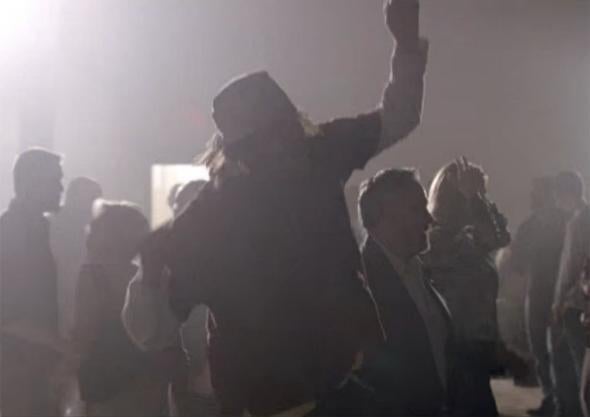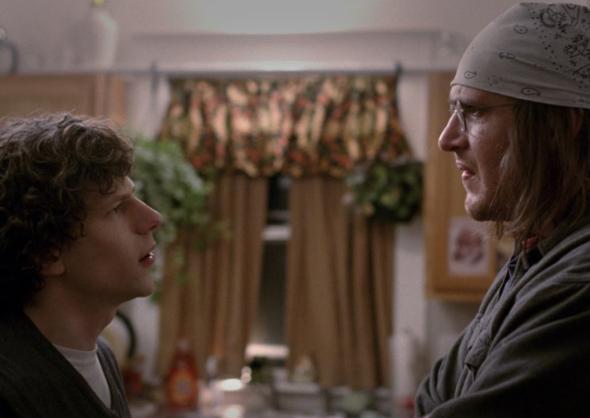This essay reveals plot points from The End of the Tour.
The one wrong note in The End of the Tour is the last one.
After sticking closely to journalist David Lipsky’s many conversations with David Foster Wallace, as transcribed in his book in his book Although of Course You End Up Becoming Yourself, the movie ends by departing, for the first time, from what Lipsky actually saw and taped on his recorder. As the warm, synthesized sounds of Brian Eno’s “The Big Ship” slowly swell on the soundtrack, we see Wallace dancing in a church, ecstatic.
Though The End of the Tour, which opens Friday, pays great attention to detail—“The Big Ship” was one of Wallace’s favorite songs, appearing in both his conversations with Lipsky and, years later, in his posthumously published The Pale King—the scene rings false. In ending the film with this moment, it seems screenwriter Donald Margulies and director James Ponsoldt are falling for David Foster Wallace’s favorite lie, just as Lipsky did years before. As D.T. Max points out in his biography of Wallace, the writer often told journalists he was going to church as cover for his attendance at recovery meetings, to stave off a relapse into drug and alcohol addiction. And if the brief vision of Wallace dancing is meant to be taken nonliterally, as a moment of him finally achieving freedom from his own self-consciousness, it’s quite untrue to the rest of the movie—which is very much about how David Foster Wallace was a terribly sad, lonely person who could never truly escape his own head.

Screenshot via The End of the Tour trailer
To be fair, The End of the Tour is far from the first portrayal of Wallace to get fooled by its own subject. The last shot of the movie is also the last image of Lipsky’s book: “And then he’s going to get dressed, and go to a Baptist church,” as Lipsky the narrator puts it, “for a dance.” Like many journalists, Lipsky was at first taken aback at this. “You dance?” he asked, but Wallace persisted, and Lipsky took him at his word. No less than New York Times columnist Frank Bruni, in his skeptical profile of Wallace for the New York Times Magazine, was also taken in. Describing Wallace’s relationship with the Poags, an older couple that, as Max notes, Wallace met in his recovery circle, Bruni writes, “They met at a Mennonite house of worship.” In Wallace’s nonfiction, too, he camouflaged his friends from his recovery group as acquaintances from church. In his meditation on Sept. 11, “The View From Mrs. Thompson’s,” Mrs. Thompson is described as “a longtime church member and a leader in the congregation.” As Max writes, “Mrs. Thompson” was the pseudonym Wallace used for the mother of his best friend from recovery. Over the years, all these references to Wallace’s friends from church mounted, accumulating in the record until they confused some readers. In 2012, a writer for Andrew Sullivan’s blog Daily Dish cited some of these passages and worried that those who wrote about Wallace weren’t paying enough attention to his “church-going and attachment to Christianity.”
Wallace did have some good reasons for not revealing which of his friends were from recovery programs. As he explained to Lipsky:
I’m not in the program, and I wouldn’t want it to come off like somebody who’s in the program. And that’s just how it’s gotta be. … I believe, I don’t know that much about it, but I believe the phrase in the eleventh tradition is “Maintain anonymity at the level of press, radio, and films.” About which, it’s one of the few things they’re adamant about.
That quote, from the widely used “Twelve Traditions” guidelines for 12-step programs, is delivered by Wallace—in the context of denying he’s in the program—essentially verbatim. It would indeed have been inappropriate for Wallace to out other members of his recovery group.
But, as The End of the Tour captures very well, Wallace also obsessed over the way he was depicted in the press and in the public imagination, and he presented a highly constructed version of himself to journalists. In reality, per Max, Wallace didn’t “belong” to any one church the way he claimed in “The View From Mrs. Thompson’s.” Instead, he bounced from church to church “as a sipper,” because “he liked one’s pageantry, the other’s earnestness, the Danishes at a third.”
And just as he was never quite able to think his way into finding faith, Wallace was never quite able to stop thinking for long enough to achieve the kind of mindless ecstasy seen in the final shot. This evidences itself in part in just how much Wallace loathed dancing. When he entered into a relationship with the poet Gale Walden in the ’80s, Max writes, “They agreed she wouldn’t have to play tennis and he wouldn’t have to dance.” Later, when he finally succeeded in winning over the writer Mary Karr, whom Wallace had pursued obsessively (and even stalkerishly) for years, Max writes that, for her, “Wallace even was willing to dance, though only to the slow music.” In his first novel, The Broom of the System, Wallace conveys, through one of his characters, a little bit of why he so hated to boogie:
Modern party-dance is simply writhing to suggestive music. It is ridiculous, silly to watch and excruciatingly embarrassing to perform. It is ridiculous, and yet absolutely everyone does it, so that it is the person who does not want to do the ridiculous thing who feels out of place and uncomfortable and self-conscious … in a word, ridiculous. Right out of Kafka: the person who does not want to do the ridiculous thing is the person who is ridiculous. … Modern party-dance is an evil thing.
But Wallace obsessed over escaping his own head in other ways, too. He so envied this kind of mindlessness that, in two of his novels, he depicts characters who can escape self-consciousness as able to literally levitate. In Infinite Jest, it’s Lyle, the guru of the locker room, who contrasts with the Wallace-like Hal Incandenza, who can’t help but overthink every stroke of the tennis racket. In The Pale King, it’s the virtuosic IRS agent Drinion:
Drinion is actually levitating slightly, which is what happens when he is completely immersed; it’s very slight, and no one can see that his bottom is floating slightly above the seat of the chair. One night someone comes into the office and sees Drinion floating upside down over his desk with his eyes glued to a complex return, Drinion himself unaware of the levitating thing by definition, since it is only when his attention is completely on something else that the levitation happens.
Wallace’s quest to achieve such a state occupied many of his final years, and not only as the idea at the center of The Pale King. He studied Eastern religion and tried to meditate, but he obsessed over things like whether he was sitting the right way. (“Is it half-lotus or nothing?” he asked a Zen Buddhist. “If so, why?”) When Wallace attended a two-week meditation retreat in France run by the Zen master Thich Nhat Hanh, Max writes, “He found that writing about mindlessness and achieving it for oneself were two different things; he left early, blaming the food, and was home as soon as he could be.”
Ironically, in getting all this wrong, the final shot inadvertently underlines another one of the movie’s great subjects, which is the true unknowability of Wallace. Some viewers may also see it as a deliberately hopeful image, a vision of Wallace in heaven, finally free from his own head. But Wallace—as brilliant as he was—wasn’t able to escape his own mind, or the disease of depression that plagued it, and he could never quite bring himself to believe in heaven, either. Instead, in trying to depict Wallace, for a moment, finally free from self-consciousness and his worries over his own celebrity, the movie fell for a story he told because of how self-conscious he really was.
